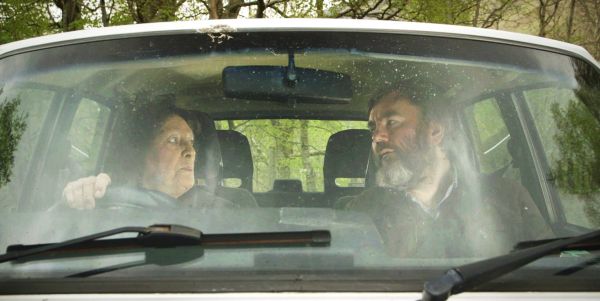In a time when facts, figures and certainties are thin on the ground, when reality itself appears to be fragmented into many non-congruent shards, it is perhaps not so surprising that some sense of perspective can be gained in the comforting darkness of the cinema theatre.
Discombobulated by events both political and personal, I sought refuge from Manchester’s silvery anti-summer at a screening of Paul Fegan’s Where You’re Meant To Be, chronicling musician Aidan Moffat’s journey around Scotland in his quest to re-interpret some of the country’s folk standards in a more contemporary light.
Throughout the film and the subsequent Q & A with Fegan and Moffat at Manchester’s Home, the theme of authenticity surfaced from the loch of uncertainty that clouds our ability to make sense of these times. The film revolves around the central tension between “traditional” versions of Scottish ballads, as performed by the legendary, late Sheila Stewart and Aidan Moffat’s desire to make those same songs fresh, revitalised and relevant to a contemporary audience through changing the lyrics whilst retaining the sense of the songs.
Preserving Scottish Heritage
Moffat’s mission is undertaken with a reverence and desire to see his musical heritage preserved for the future in an animated, living state rather than consigned to the past, trapped by archaic forms and exhibited in cultural museums. It is one that he undertakes with a sensitivity that refuses to crumble into sentimentality. Sheila Stewart however, in common with other guardians of the tradition, disagreed, insisting that their versions were the standards from which deviation is not to be tolerated.

Also, within the film, we are presented with the tension between two Loch Ness monster hunters, at odds over the veracity of their claims of sightings of the fabled creature off the banks of Drumnadrochit. One of the monster hunters is castigated for admitting to have falsified sightings to boost tourism… whereas the other monster hunter is outraged by so blatant a departure from – from what exactly?
In isolation, the case of Nessie and the industry that thrives on the banks of the famous loch, with a history of passionate dispute – e.g. fist fights over which is the most official Nessie centre (though this also may be apocryphal) – is endearingly bizarre. Within the context of the film though, both Nessie and Scottish ballads become battlegrounds for authenticity, notions of truth, meaning and the issue of ownership, or where the locus of such values might reside.
Nessie & Scottish Ballads: Battlegrounds For Authenticity
Aidan Moffat finds himself on screen, wandering his native land suddenly immersed in a Sartrean quagmire. What may appear to be a slight deviation from the norm – especially to the uninitiated – in fact rents the thinly intertwined skein of meaning asunder and questions arise on the long, low road into the night.
In the Q & A after the showing, the point was made about how it has become an illustrated tea towel cliché that everything modern was invented in Scotland. The significance of such claims has always struck me as impressive due to the ratio of population size to the magnitude and quantity of some of those inventions and discoveries, with industrial Manchester boasting a similarly impressive history of innovation.
But it’s rarely commented on the significance of the most famous shot of the Loch Ness Monster from 1934, albeit taken by an English gynaecologist, Robert Kenneth Wilson. The fact is that this image (and perhaps the fact that it is an image) of Nessie, despite the revelation some years ago that it is a fake, remains synonymous with the myth. The industry endures palpably, not just on the level of the average tourist who enjoys temporarily buying into the fantasy, but on a number of complex and inter-related levels of epistemology, proponents of which passionately defend their delineated territories by degrees of reality.
A Touchstone of the Post-Modern 21st Century
Rather than modernity being invented in Scotland, it seems to me that Wilson’s image is the touchstone of the post-modern 21st century in which we now find ourselves questioning what is real with alarming urgency.
The true nature of authenticity always slithers and slips its scaly hide through your tightening fingers every time you seize upon it. But maybe its meaning and value lie in the pursuit rather than the quarry, the peregrinations that lead you to discover Where You’re Meant To Be.
Does content like this matter to you?
Become a Member and support film journalism. Unlock access to all of Film Inquiry`s great articles. Join a community of like-minded readers who are passionate about cinema - get access to our private members Network, give back to independent filmmakers, and more.